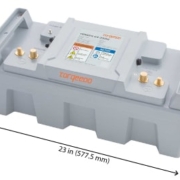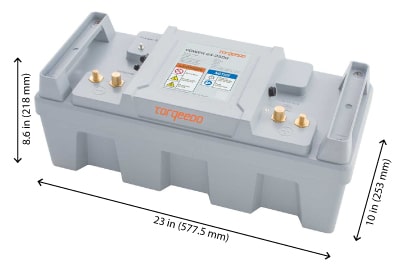Available Energy Stored in a Battery
You don’t actually run all of the electron charge out of a battery when it is considered empty. Rather it is considered “empty” or “flat” when the voltage drops below 10.5 volts. At this voltage, it is considered ineffective to run any 12-volt system.
Lead acid batteries are rated in Amp-hrs which is another form of saying how much energy they hold. Since batteries are a bit complicated, this rating comes from how many amps could the battery consistently supply over a 20-hour period before the voltage drops below 10.5 volts. It is also the amount of effective energy in the battery.
For example, a standard 12-volt lead acid battery on a sailboat is usually rated for around 150 amp-hours. That means it could supply 150amp-hrs/20 hrs at greater than 10.5 volts = 7.5 amps flow of current for 20 hours. The 7.5 comes from 150/20 or 7.5 amps x 20 hours = 150 amp-hrs.
Since power = volts times amps, the battery could supply 90 watts (12volts x 7.5 amps) continuous for 20 hours. This means that the battery holds 90 watts x 20 hours = 1800 watt-hours = 1.8 kW-hours of energy.
i.e. to convert from amp.hrs to watt.hrs, multiply by the voltage. For a 12 volt battery, multiply by 12.
e.g. a 150 amp hour battery holds 1800 watt.hours (1.8 kW.hrs)
Actually Amp.hrs which is the energy rating of a battery, is a bit of a funny (funny-strange not funny-haa haa) measurement. There really is no such unit of energy as an amp.hr. But it the USA especially, you’ll see that a battery is rated as for example 200 amp.hrs. What they really mean is for a 12 volt battery the amount of useful energy is 200 x 12 = 2400 watt.hrs or 2.4 kW-hrs. If it was a 24 volt battery, a 200 amp.hr battery would hold 200 x 24 = 4800 watt-hrs or 4.8 kW-hrs. Thus Amp.hrs is a frustrating unit of energy measurement because you always have to ask the next question “At what voltage?” This is because volts x amps is the measurement of power (and power used in an amount of time is energy)
Always multiply the amp.hrs by the voltage to get the watt-hrs.
Quick example: how long would it take to deplete a 150 amp.hr battery (12v) (down to 10.5 volts) if it was being drained by a 60-watt device?
ANS: A 150 amp.hr 12 volt battery holds 150 x 12 = 1800 watts-hrs of energy.
1800 watt.hrs / 60 watts = 30 hours.
Some Battery Background:
AGM stands for Absorbent Glass Mat.AGM technology became popular in the early 1980s as a sealed lead acid battery for military aircraft, vehicles, and UPS to reduce weight and improve reliability. The sulfuric acid is absorbed by a very fine fiberglass mat, making the battery spill-proof. This enables shipment without hazardous material restrictions. The plates can be made flat to resemble a standard flooded lead acid pack in a rectangular case; they can also be wound into a cylindrical cell.
AGM has a very low internal resistance, is capable of delivering high currents on demand, and offers a relatively long service life, even when deep cycled. AGM is maintenance-free, provides good electrical reliability, and is lighter than the flooded lead acid type. While regular lead acid batteries need a topping charge every six months to prevent the buildup of sulfation. AGM batteries are less prone to sulfation and can sit in storage for longer before a charge becomes necessary. The battery stands up well to low temperatures and has a low self-discharge.
The leading advantages of AGM are a charge that is up to five times faster than the flooded version, and the ability to deep cycle. AGM offers a depth-of-discharge of 80 percent; the flooded, on the other hand, is specified at 50 percent DoD to attain the same cycle life. The negatives are slightly lower specific energy and higher manufacturing costs than the flooded, but cheaper than the gel battery.
Lithium-ion batteries, on the other hand, discharge in a less complicated fashion than lead acid, and thus they are rated conveniently in kilowatt-hrs of stored energy. Lithium-Ion batteries have a higher energy-to-weight and space density than AGM but that comes at a cost of approximately $850 / kW.hr for Li-Ion compared to about $300 / kW.hr for AGM.
The Torqeedo Lithium-Ion “Power 24-3500” is a 24-volt 3.5kW.hr battery. It comes in a convenient to manage size 23 in x 8.6 in x 10 in (577.5 mm x 218.5 mm x 253.5 mm) and weighs 55 lbs (25.3 kg). Its cost is $3000 or $850 per kWatt.hr.
Its energy density is 3500 kW.hr/25kg = 140 watt.hrs/kg
Compare this to a 200 amp.hr 12 v (grrr on the units) (2.4kW-hr) AGM lead acid battery. It weighs approximately 130 lbs (60 kg) and costs about $800 or $330 kWatt.hr. The energy density is 2400/130 = 40 watt.hrs/kg.
Thus the Li-Ion is 3.5 times the energy density but this comes at a cost. The cost per watt.hour, for the Li-Ion is greater at about 2.5 times more expensive.
As with anything, it is a trade-off. Save 3.5 times the weight for 2.5 times the cost.
To put this all in perspective, the table below shows a typical boat requiring 4 kWatt-hrs of stored energy.
| Tyical Boat Requiring 4 kWatt-hrs of Stored Energy |
Weight | Cost |
| Li-Ion | 28 kg | $3400 |
| AGM | 100 kg | $1350 |
Available Energy on your Boat
Now you can calculate the amount of energy on your boat. Check the amp.hrs rating on your house batteries and add them up and multiply by 12 – assuming your boat is a 12-volt boat. (Who decided that amp.hrs was a good unit anyway?)
You can connect multiple batteries together to store more energy on your boat. If you have two 150 Amp.hr batteries in the house battery bank, then you have 2 x 1.8kW.hr = 3.6 kW.hrs of available energy.
If you put two 3.5 kWatt.hr Li-ion batteries on your boat you’d have 7 kWatt.hrs of available energy.







